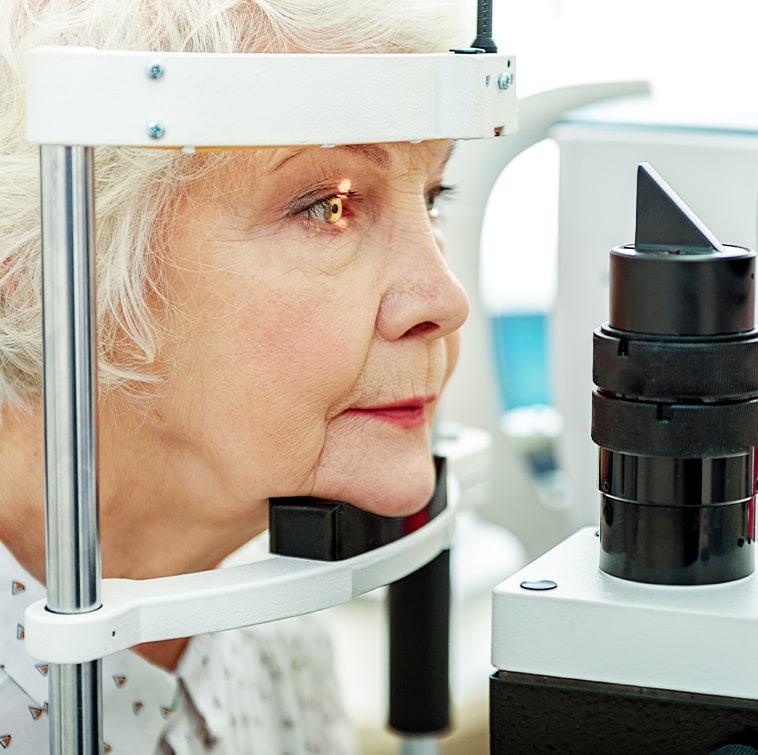
Protecting Your Eye Health
In younger patients, eye diseases are less common than standard refractive issues like myopia (nearsightedness) and hyperopia (farsightedness). In older patients, however, the eyes can start to deteriorate, and vision issues may become more than just a minor inconvenience.
The team at Golden Vision can combine experience and knowledge with access to modern eye care technology to solve many of these problems. We also refer patients to specialists where we know they’ll get the best care.
Text us today for an appointment.

Eye Conditions
Our eyes change as we age, altering the types of eye problems we’re more likely to experience and impacting our eye care. Many eye conditions and diseases can occur at any age, but older adults have an increased risk of developing ocular issues. Regular eye exams are crucial for prevention and treatment throughout your life.
In children, the most prevalent eye conditions are refractive errors, amblyopia (lazy eye), strabismus, and congenital anomalies. Adults over 40 have the greatest risk for eye disease, including many preventable conditions.
The American Optometric Association (AOA) recommends eye exams every 2 years for adults and annually for children. However, when you experience symptoms or vision changes, it is important to contact your eye doctor at Golden Vision Optometry. Visiting your optometrist more frequently allows your eye care team to monitor your ocular health and symptoms associated with eye disease.
Cataracts
A cataract is a clouding of the eye’s normally transparent lens. Cataracts are more common in adults over 55 as it develops due to changes to proteins and fibers in the lens. However, cataracts can develop at any age, including infancy.
While cataracts typically occur in both eyes, patients can experience worse vision in one eye. Common symptoms include:
- Blurred or hazy vision
- Light sensitivity
- Prescription changes
- Poor color vision
- Reduced night vision
In the early stages of development, prescription glasses or contacts can help improve vision. Depending on the size and location of the cloudy area, it may not interfere with most visual tasks.
However, when the condition progresses, cataract surgery may be an option. Traditional cataract surgery (phacoemulsification) is one of the most commonly performed surgeries in the world.
Glaucoma
Glaucoma is a group of eye diseases characterized by damage to the optic nerve. The optic nerve has a bundle of over one million nerve fibers that transmit images (sent as electrical signals) from the retina to the brain.
The most common cause of glaucoma is increased intraocular pressure (IOP). When fluid in the eye (aqueous humor) cannot drain effectively, eye pressure builds as fluid volume increases.
Most forms of glaucoma develop slowly, and patients may not immediately notice symptoms. As the optic nerve deteriorates, it begins affecting peripheral (side) vision, particularly vision that is closest to your nose.
When glaucoma develops rapidly, symptoms can include:
- Blurred vision
- Eye pain or redness
- Halos around lights
Typically, prescription eye drops are the first treatment method. When less invasive treatments are unsuccessful, your eye doctor may recommend a surgical approach. Treatment for glaucoma can include:
- Drainage implants
- Laser trabeculoplasty
- Trabeculectomy
Preventing optic nerve damage is crucial for preventing vision loss. Glaucoma screening can help detect changes in eye pressure and monitor eye health. Text us to book glaucoma testing at Golden Vision Optometry to protect your sight.
Conjunctivitis (Pink Eye)
Conjunctivitis, commonly known as pink eye, is an eye condition concerning conjunctival inflammation. The conjunctiva is a transparent, thin tissue covering the sclera (whites of your eyes) and inner eyelids. It helps protect the eye’s surface and prevents debris, dust, and particles from entering the eye.
Allergic and chemical conjunctivitis is caused by eye contact with an irritating substance. For example, chemical conjunctivitis might occur because cleaning products or perfumes reach the eye. For both allergic and chemical conjunctivitis, removing the environmental irritants or allergens eliminates symptoms.
Infectious conjunctivitis is highly contagious. Typically, viral conjunctivitis is caused by adenoviruses (associated with the common cold). Bacterial conjunctivitis is caused by contact with bacteria, including contaminated facial products or makeup, unclean hands, and improper contact lens care.
Although symptoms can vary depending on the type, common symptoms include:
- Crusty eyelids
- Discharge (watery or yellow)
- Eye redness
- Eyelid swelling
- Gritty sensation
- Itchy eyes
- Light sensitivity
While conjunctivitis can resolve on it’s own, it crucial to seek treatment to prevent spreading the infection and reduce the risk of complications. Your eye doctor can prescribe eye drops, ointments, and other treatment methods including antibiotics. Contact Golden Vision Optometry for treatment when you experience eye redness, irritation, or discomfort.
Keratoconus
Keratoconus is a vision disorder affecting the cornea (front of the eye). Normally, the cornea is a rounded, convex shape. It allows light to enter the eye and focus on the retina (light-senstive tissue at the back of the eye).
Keratoconus occurs when the cornea thins and becomes irregularly shaped, usually cone-like. The abnormal shape prevents light from entering the eye properly, resulting in distorted vision.
Keratoconus is a progressive condition, so early detection is crucial in preserving vision. Over time, the changes to the cornea can cause bulging and swelling, causing the cornea to crack. Although the cornea can heal, scar tissue can interfere with clear vision.
In the early stages of development, eyeglasses or contact lenses can offer vision correction. Some patients can benefit from surgical treatments such as a corneal transplant or corneal cross-linking.
Macular Degeneration
Macular degeneration is also commonly called age-related macular degeneration (AMD) because it’s more common in older adults. It’s the leading cause of vision loss for adults over 50 but the disease can develop at any age.
AMD occurs when the macula (center of the retina) is damaged. Macula damage can cause:
- Color vision loss
- A dark or empty area in central vision
- Decreased detailed vision
- Distorted shapes or lines
There are 2 types of macular degeneration: dry and wet.
- Dry AMD is more common and accounts for 80% of AMD cases. It develops when the macula grows deposits (drusen), impairing central and color vision. Dry AMD can also cause visual distortions in lines or shapes.
- Wet AMD is less common but develops more quickly. Wet AMD develops due to abnormal blood vessels growing under the retina. The blood vessels can leak fluid, causing tissue scarring and impairing macula function.
There is no treatment available for dry AMD, but eye care, nutrition, and healthy lifestyle habits can help slow progression. Treatment for wet AMD includes anti-VEGF injections or laser surgery.
Retinal Detachment
The retina is a thin tissue layer located at the back of the eye. It’s a crucial part of vision, as the retina contains light-sensitive photoreceptors which allow the eye to gather visual information. Light enters the eye and is focused on the retina through the cornea and lens.
The retina collects visual information to form images. Then, the retina sends the images to the optic nerve. Finally, the optic nerve translates the visual information into electric signals and sends it to the brain.
Retinal detachment is when the retina is partially or fully separated from the back of the eye. Typical symptoms include flashes of light (photopsia), floaters or spots, and central vision loss. Without treatment, retinal detachment can lead to blindness.
Some common risk factors include:
- Cataract surgery complication
- Glaucoma
- High myopia
- Loss of vitreous fluid
- Ocular trauma
- Lattice degeneration
Retinal Detachment Treatment
Repairing retinal tearing or detachment is a medical emergency that requires surgery. For holes or tears, an eye doctor may perform laser surgery (photocoagulation) or freeze treatment (cryopexy). For a more significant tear or detachment, there are 3 types of surgical options:
It’s crucial to seek treatment as soon as possible. Chances of success increase the sooner your eye doctor can implement treatment. In 90% of cases, retinal repairs are successful.
Preserve Healthy Vision
Monitoring your eye health with regular eye exams is crucial to preserving healthy vision. Book an appointment with our knowledgeable and compassionate team at Golden Vision Optometry. Experience the Golden Vision difference today! Text us for an appointment.

Our Services
Our Locations

We have 9 convenient locations throughout California to serve you. We’re constantly growing, so you and your family always have access to the services you need.
Our Google Reviews
Check us out on Instagram
Error: No feed found.
Please go to the Instagram Feed settings page to create a feed.







